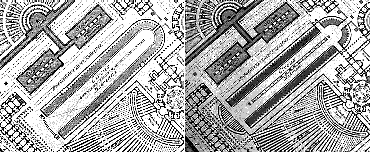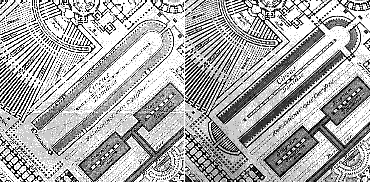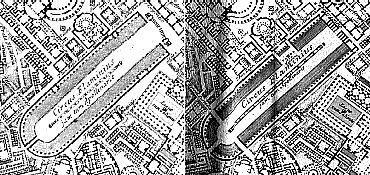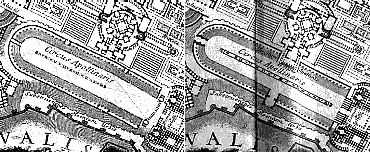2000.05.15
one more Piranesian daze: circus act
In attempting to discern the possible reason or message manifested by the plan changes to the Circus of Caligula and Nero and to the Circus Agonalia, I began to think of these specific circuses and how they may or may not relate to the numerous other circuses delineated throughout the Ichnographia. Within the version of the Ichnographia that is presently widely published there are six circuses, the Circus Caji et Neronis, the Circus Agonalia, the Circus Hadriani, the Circus Domtiae, the Circus Flaminius, and the Circus Apollinaris. With only minor adjustments to length, each circus is delineated in a virtually identical fashion, and, moreover, each circus reflects an archaeologically correct circus plan. As already illustrated, the plans of the Circus Caji et Neronis and the Circus Agonalia within the University of Pennsylvania Ichnographia reflect more stylized, i.e., archaeologically incorrect, circus formations. Since all the circuses are identical in the widely published version of the Ichnographia, I then began to wonder, via transposition, whether all the circuses within the Penn Ichnographia were likewise identical there in the form of exhibiting plan changes. In all honestly, I had not noticed any plan changes to the circuses other than the Circus Caji et Neronis and the Circus Agonalia the two times I had seen the Penn Ichnographia prior, but nor did I have any pictorial hardcopy evidence that there are no other plan changes. Having worked with the Ichnographia for over ten years, if I have learned anything, it is that the Ichnographia, no matter how well you think you know it, continually maintains the uncanny ability to beguile. Therefore, it was necessary for me to once more return to the other Ichnographia.
Upon doing further research, i.e., going back to the University of Pennsylvania's Fine Arts Library to again scan the Ichnographia Campus Martius, more plan changes were indeed discovered, and, just as I had begun to suspect, the "change of plans" effected the Circus Hadriani, the Circus Domitiae, the Circus Flaminius, and the Circus Apollinaris. Thus, it is now evident that each of the major "changes of plan", between the Ichnographia Campus Martius that is widely published and the Ichnographia Campus Martius within the rare book collection at the University of Pennsylvania's Fine Arts Library, occur more or less exclusively within those buildings of the Ichnographia labeled "circus".

The plan above left is the Circus Hadriani as it appears within the commonly reproduced Ichnographia. Above right is the Circus Hardiani as it appears within the Ichnographia at the University of Pennsylvania.

The plan above left is the Circus Domitiae as it appears within the commonly reproduced Ichnographia. Above right is the Circus Domitiae as it appears within the Ichnographia at the University of Pennsylvania.

The plan above left is the Circus Flaminius as it appears within the commonly reproduced Ichnographia. Above right is the Circus Flaminius as it appears within the Ichnographia at the University of Pennsylvania.

The plan above left is the Circus Apollinaris as it appears within the commonly reproduced Ichnographia. Above right is the Circus Apollinaris as it appears within the Ichnographia at the University of Pennsylvania.
As the above plan comparisons indicate, the newly discovered circus plans engage directly with their neighboring buildings, thereby rendering a connected contextualism and demonstrating a more integrated urban planning methodology. The circus plans of the commonly reproduced Ichnographia on the other hand, albeit archaeologically correct, do not engage their immediate surroundings, and appear as though literally afterthoughts. Beside the already mentioned questions as to what these changes might mean and which set of plans came first, or what Piranesi's intentions in making the changes might have been, there is now an additional question as to why the changes were specifically and only applied to the Campo Marzio's six circuses.
| |
2000.05.16
another Piranesian daze
Yesterday, I went back to Penn to again scan the Ichnographia Campus Martius, and just as I'd begun to suspect, all the circuses within the Ichnographia show a change of plan. Just now I'm thinking that the version at Penn does indeed represent the true work of Piranesi, and that the plan as commonly published is a post-Piranesi change, in fact, it may be a change that was done after the Ichnographia copper plates were no longer in the Piranesi family's possession. (If I recall correctly, the copper plates went to France, and it was there that latter editions of Piranesi's work were printed. It may be that someone in France thought it best to make the circuses of the Ichnographia archeologically correct.) The notion that the plan changes were done post-Piranesi, and even post-Francesco Piranesi fits well with the fact that the Penn volumn already contains a frontispiece by Francesco [sic], and indeed the circuses of Hadrian and Domitiae in the Francesco frontispiece comply with the "uncommon" circus plans, thus suggesting that the plan changes were not only not done by Piranesi, but not done by his son Francesco as well. (I actually have a very interesting case here.)
Having the plan changes done by a third (and later) party implies that when virtually all of us today look at the Ichnographia we are literally not looking at the large plan as Piranesi intended it to be seen, and this is a perfect segue into to how today, because of Tafuri, virtually all architects are seeing even less of Piranesi's true intentions.
2000.05.28
the Piranesian point of no return
Well beyond the Piranesian point of no return--title of a book I could complete sometime this summer.
2000.06.02
Signs of SagaCity
Another quick book: Signs of SagaCity--this is yet the latest working title for a first person singular book on Piranesi's Campo Marzio. I feel I am a step closer to having this project come altogether. Early on I had the idea of assigning Campo Marzio tombs-sepulchers to each architect or historian that has made Campo Marzio mistakes thus far. Of course, what is really going on is my own internal battle to see what "Piranesian Daze" actually ultimately evolves into. This clearly implies that I'm still mentally searching for an ultimate Piranesi/ Campo Marzio "quick & easy" formula (if there will ever be one).
2000.06.23
new books
Virtually Carved in Stone: a masterplan of mistakes and inversion
2000.07.09
ideas
Campo Marzio: Tafuri is arbitrary; not Piranesi.
2000.07.23
Ichnographia
I've decided to begin "redrawing" the rest of the ichnographia by my own design. I first envisioned a slapdash design for the theater of Pompey, and then I quickly realized that all the plans that are left to be redrawn can be also redesigned (just as Piranesi redesigned; another reenactment), while I adhere only to the labels and locations Piranesi uses. Of course, the new plans will be my own crazy designs, yet I will have all the Campo Marzio research data to use as inspiration, thus there are a great many reenactments to be performed.
I'm realizing that there can be many reenactments of the redrawing, and ultimately all I really have to consider is that again the infinite collection thereby is manifested. For starters, I will orient the ichnographia to true north and I will orient the Philadelphia plan to true north as well. Then I will overlay the two plans with Hadrian's tomb and Logan circle as the registration point. From there I will begin considering the implications of both/either palns in 2d and 3d.
Also: Mirage City as a reenactment of Rome Interrotta.
2000.09.07 13:13
reenactment season begins
So where does architect Aldo Rossi fit in this happening of live, death and triumphal way? Oddly enough, the answer lies again within ancient Rome by way of Piranesi's Campo Marzio. There is a documented but not too often recognized direct relation between Piranesi's design of the Bustum (place where bodies are burned and buried) Hadriani and Rossi's design of Modena Cemetery. Piranesi's design constitutes an axis of death, and Rossi discovered this death axis quite some time ago, for it reappears in his cemetery at Modena.
| |
2000.11.20
9 November 1778
Yesterday morning I was looking through the recent Taschen publication of Piranesi's complete etchings, and therein I noticed that Piranesi died on 9 November 1778. With respect to my last post here, I'm now at least pleased that information seems to be 'participating' with my obscure architectural/theoretical researches/entertainments. At the very least I'm now mostly happy that Helena, Eutropia, Constantine and Piranesi still manage to exhibit signs of life. Architectural aesthetics and theories provide such an enormous fertile field, that it seems very true that the best way to enjoy it all is to plant seeds, supply some nurturing, and then watch some tremendous fruit bearing growth emerge.
Piranesi, as far as I can tell, was the most recent past architect/theorist to give architectural homage to Helena. Four plates in the Antichita Romane vol. III depict Helena's (ruined) mausoleum in Rome plus her sepulcher (which is now in the Vatican Museum). In vol. II of the Antichita Romane there are four plates that depict (what is today called) Santa Costanza, (originally the mausoleum of Constantina, the daughter of Constantine, and the grand daughter of Helena and Eutropia), plus Constantina's sepulcher (which is now also in the Vatican museum in the same room as Helena's sepulcher). Piranesi also offers a reconstructed plan of the original Constantinian basilica (it was quite huge) built over the catacomb where St. Agnes was buried, to which Santa Costanza was originally attached.
It was through my research of St. Agnes (on April 1, 1999 - Holy Thursday) in relation to my ongoing research of Piranesi's Ichnographia Campus Martius that I first found out about St. Helena.
I would love to be able to confidently tell you all to trust me when it comes Helena and Piranesi, but I really can't do that without somehow or another seeing things get messy. Nevertheless, I will ask you to trust me when I say that I really enjoy architecture talk, and I therefore really enjoy architecthetics because this is one of the few places (as unreal as it is) that I get to do the talking I enjoy doing.
2000.11.26
Piranesi texts in chronological order
I thought that the best way to begin a thorough critique of contemporary criticism/texts on Piranesi' Campo Marzio is to simply list them all in chronological order, and from there analyze the contents of each text. As much as this is an organizational devise, it is also hoped to engender further insight into the whole emergence of the Tafurian point of view vis-a-vis the emergence of the theory of "reenactment".
2000.12.01
context (Quondam thinking?)
I don't have to tell all of you how much I look to/at Rome, but I should mention that the main reason I started redrawing and studying Piranesi's Campo Marzio (and all the subsequent ancient Roman studying being done like on St. Helena) is because I was inspired by the fact that Louis I. Kahn, throughout his mature years, had a copy of Piranesi's Campo Marzio plan hanging on the wall over his desk at his office. After Learning From Las Vegas, Venturi next published a group of essays under the title A View From the Campidoglio, and just a few years ago it dawned on me that when one is actually standing at the Campidoglio in Rome, the view being taken in is literally Rome's Campo Marzio. I'm going to make one final bold statement here, and that is to ask you to now trust me when I say that I continue to see what some of Philadelphia's best architects looked at.
2000.12.12
..... language [and innuendo?]
The current discussion on architectural language reminds me of a small exhibit at Quondam online earlier this year [labeled innuendo. In a general sense, the display deals with the 'language' and meaning of architectural planimetric forms, while specifically the display deals with the 'master key' that unlocks the long held mysteriousness of Piranesi's Ichnographia Campus Martius (i.e., the large plan of the Fields of Mars). And in hyper-contextual terms, the display refers to the two rapes that generated Rome: the rape of the Vestal Virgin Rhea Silvia by the god Mars, which in turn produced Romulus and Remus, and then the rape of the Sabine women, an attack planned by Romulus in order to further populate his newly founded namesake urbs. That's rape, then rape reenacted, then Eternal City! What better way to institute a 'place' then with the notion "like father, like son."
2000.12.13
more on language
...when you say/ask: "I was (and remain) concerned in the present context simply to ask whether there are any arguments for (a language of architecture--that is, something construed in terms of the primary components of language (syntax, semantics, pragmatics) and attendant accounts of the phenomenology, originary foundations, physical characteristics, and so forth.) that go beyond appeals to a metaphorical sense of 'language'. I haven't come across any, and so I appeal to the list to see if anyone else has," I admit to not being entirely sure what it is that you're after, but that may be because I have yet to re-read prior posts. In any case, your question made me think of Tafuri's criticism of Piranesi's Ichnographia Campus Martius where he states (in The Sphere and the Labyrinth, p. 38):
The ambiquity of the Campo Marzio now becomes evident; it is at once a "project" and a denunciation. As a disenchanted documentation of the impossibility of an unambiguous definition of language, it--projecting this situation into the past--sounds like a merciless satire of the infinite capacity of late-baroque typology to reproduce itself metamorphically. (The fact that in the Campo Marzio the allusion to baroque typologies is filtered through a classicist geometrism fools no one; it is simply a means of rendering metahistorical and universal the polemic already begun.) Inasmuch as it is--despite everything--an affirmation of a world of forms, the Campo Marzio, precisely because of the absurdity of its horror vacui, becomes a demand for language, a paradoxical revelation of its absence.
Negation and affirmation cannot split apart. The "na´ve dialectic" of the Enlightenment is already superseded.
The "great absentee" from the Campo Marzio, then, is language.
The absolute disintegration of formal order, of what remained of the humanist Stimmung, of its sacred and symbolic values--and, above all, of perspective as a symbolic instrument for the quantitative control of space--logically also affects the subject of Piranesi's work: the relationship between history and the present.
I interpret the above to mean that Tafuri believes the Campo Marzio cannot be coherently read or understood because, as Tafuri sees it, Piranesi presents something like xenoglossy (i.e., a trance state of a language unknown to the individual under normal conditions). Over the past several years I've been doing a lot of research and writing whereby I essentially prove Tafuri wrong in that Piranesi's large plan of the Campo Marzio can indeed be read, and, moreover, the plan is a very sophisticated double narrative telling the story of both Pagan and Christian Rome. Piranesi in fact utilizes two languages: Latin (for labeling buildings) and an architectural language of planimetrics--innuendo.
As far as I know, Piranesi's Ichnographia Campus Martius is the only example of a historical narrative that is delivered not by spoken or written language and/or pictorial illustration, but by a composition of architectural plans and their labels. If that is the case, then Piranesi's large plan is indeed a rare document where architecture is the language used to communicate a (very long) story.
|